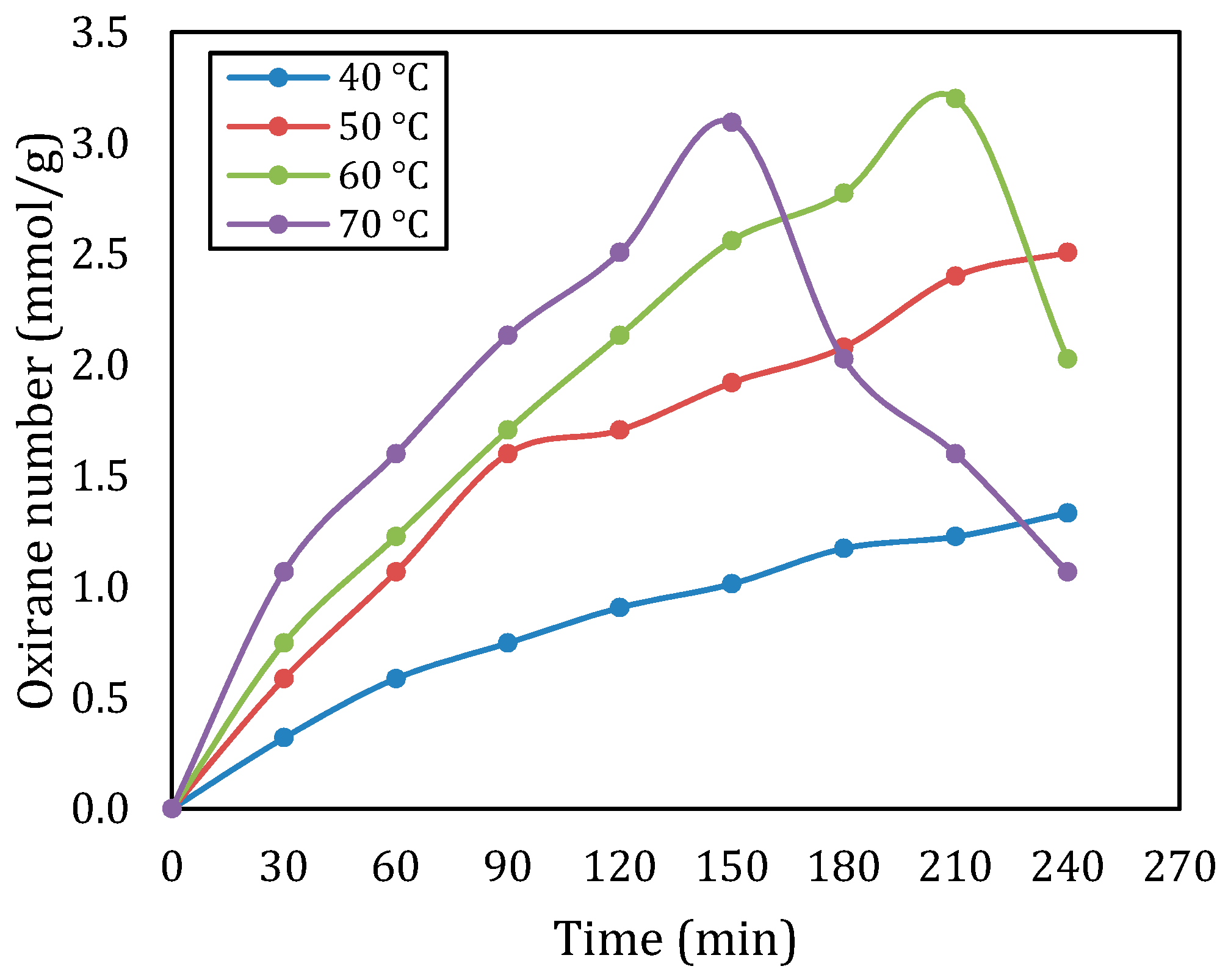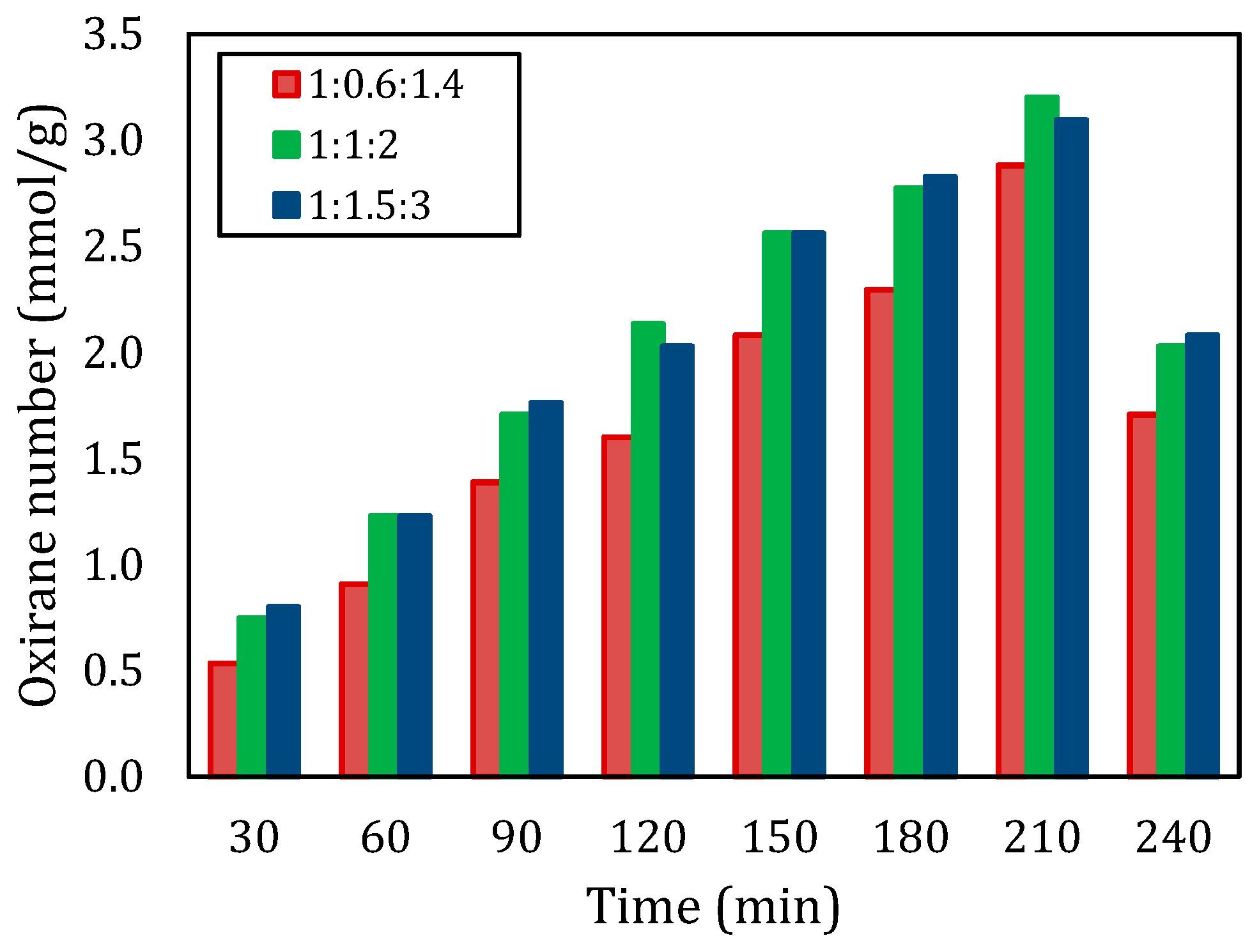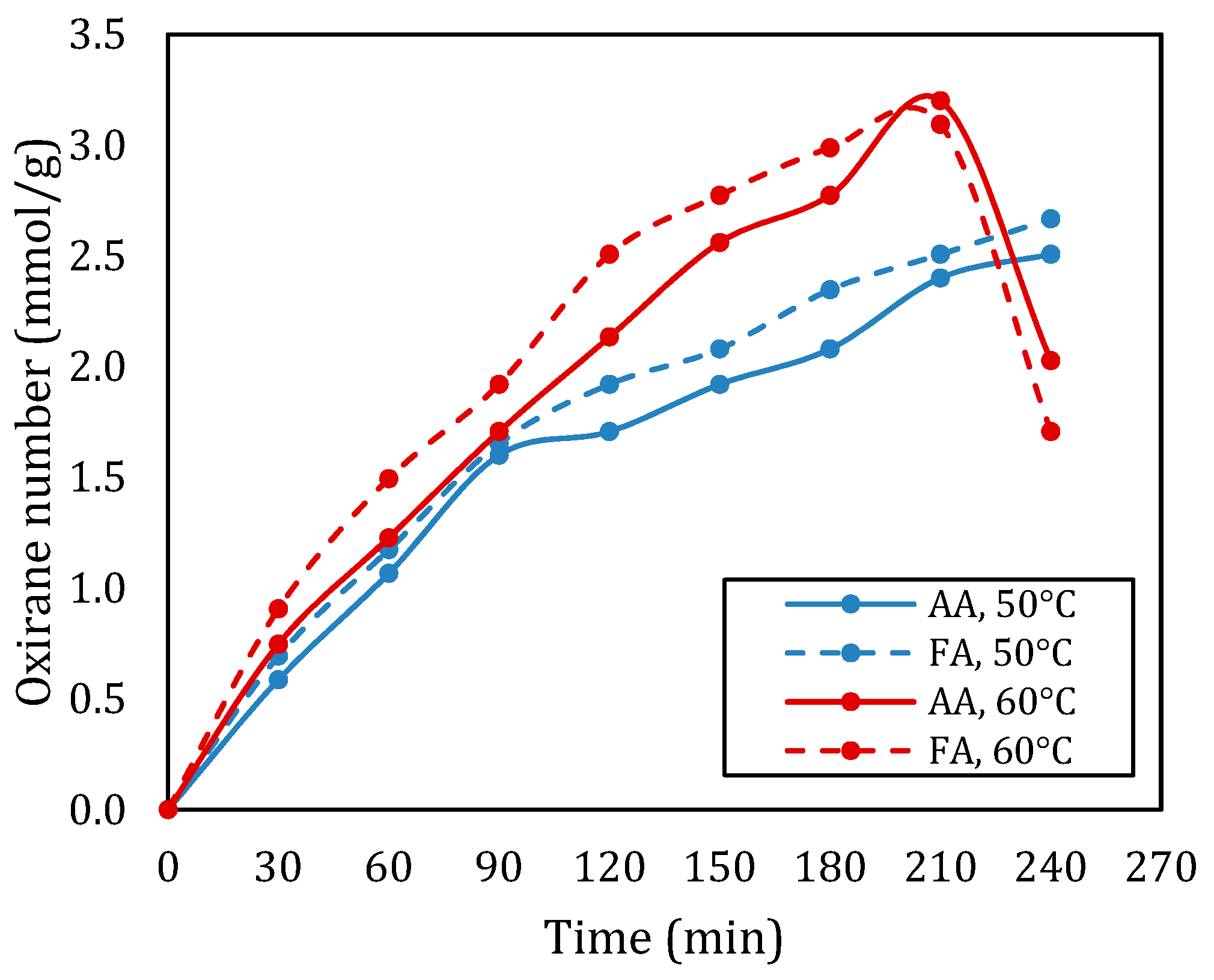The In-Situ Epoxidation of Rubber Seed Oil (Hevea brasiliensis) by Peroxyacids †
Abstract
1. Introduction
2. Materials and Methods
2.1. Materials
2.2. Epoxidation Process
3. Results and Discussion
3.1. Temperature Influence
3.2. Molar Ratio Influence
3.3. Influence of the Type of Carboxylic Acid
3.4. The FTIR Spectroscopy Data
4. Conclusions
Author Contributions
Funding
Institutional Review Board Statement
Informed Consent Statement
Data Availability Statement
Conflicts of Interest
References
- Anggono, A.D.; Darmawan, A.S.; Wijianto; Prasojo, C. Development of biodegradable plastic made from recycling of polypropylene (PP) with corn stalks powder. IOP Conf. Ser. Mater. Sci. Eng. 2019, 673, 012136. [Google Scholar] [CrossRef]
- Hidayati, N.U.R.; Mujiburohman, M.U.H.A.M.M.A.D.; Hamid, H.; Purnama, H.E.R.R.Y.; Dwilaksita, A.; Zubaida, F.R. Preliminary study of abs/chitosan blend polymer for dmfc membranes. Mater. Sci. Forum 2019, 961, 23–29. [Google Scholar] [CrossRef]
- Zeng, Y.; Shang, Z.; Zheng, Z.; Shi, N.; Yang, B.; Han, S.; Yan, J. A Review of Chemical Modification of Vegetable Oils and Their Applications. Lubricants 2024, 12, 180. [Google Scholar] [CrossRef]
- Obanla, O.; Udonne, J.; Ajani, O.; Ojewumi, M.; Omodara, O.; Oni, B. Studies of the In-Situ Epoxidation of Rubber (Hevea Brasiliensis)Seed Oil by Performic Acid. J. Phys. Conf. Ser. 2019, 1378, 022025. [Google Scholar] [CrossRef]
- Nwosu-Obieogu, K.; Umunna, M. Rubber Seed Oil Epoxidation: Experimental Study and Soft Computational Prediction. Ann. Fac. Eng. Hunedoara-Int. J. Eng. 2021, 4, 65–70. [Google Scholar]
- Putra, N.R.; Aziz, A.H.A.; Rizkiyah, D.N.; Yunus, M.A.C.; Alwi, R.S.; Qomariyah, L. Green Extraction of Valuable Compounds from Rubber Seed Trees: A Path to Sustainability. Appl. Sci. 2023, 13, 13102. [Google Scholar] [CrossRef]
- Budiyati, E.; Budhijanto; Budiman, A.; Rochmadi. Kinetic study of epoxidation of Tung oil (Reutealis trisperma (Blanco) Airy Shaw) by peroxyacetic acid. IOP Conf. Ser. Mater. Sci. Eng. 2020, 778, 012048. [Google Scholar] [CrossRef]
- Budiyati, E.; Rochmadi. The In-situ Epoxidation of Tung Oil by Performic Acid. AIP Conf. Proc. 2024, 2838, 020017. [Google Scholar] [CrossRef]
- Budiyati, E.; Rochmadi, R.; Budiman, A.; Budhijanto, B. Effects of the Molar Ratio of Acetic Acid to UFA and Stirring Velocity in the Tung Oil Epoxidation. Key Eng. Mater. 2021, 884, 117–124. [Google Scholar] [CrossRef]
- de Haro, J.C.; Izarra, I.; Rodríguez, J.F.; Pérez, Á.; Carmona, M. Modelling the epoxidation reaction of grape seed oil by peracetic acid. J. Clean. Prod. 2016, 138, 70–76. [Google Scholar] [CrossRef]
- Chen, J.; Beaufort, M.d.L.; Gyurik, L.; Dorresteijn, J.; Otte, M.; Gebbink, R.J.M.K. Highly efficient epoxidation of vegetable oils catalyzed by a manganese complex with hydrogen peroxide and acetic acid. Green Chem. 2019, 21, 2436–2447. [Google Scholar] [CrossRef]
- Budiyati, E.; Rochmadi, R.; Budiman, A.; Budhijanto, B. Studies on epoxidation of tung oil with hydrogen peroxide catalyzed by sulfuric acid. Bull. Chem. React. Eng. Catal. 2020, 15, 674–686. [Google Scholar] [CrossRef]
- Budiyati, E.; Sofyan, H.M.; Irsyad, N.; Salsyabila, A.; Musthofa, M. Mass transfer and reaction rate parameters for the in-situ epoxidation of tamanu oil. Chem. Pap. 2024, 78, 4131–4141. [Google Scholar] [CrossRef]
- Sawitri, D.R.; Mulyono, P.; Rochmadi; Hisyam, A.; Budiman, A. Kinetic investigation for in-situ epoxidation of unsaturated fatty acid based on the Pseudo-steady-state-hypothesis (PSSH). J. Oleo Sci. 2020, 69, 1297–1305. [Google Scholar] [CrossRef] [PubMed]
- Raofuddin, D.N.A.; Azmi, I.S.; Jalil, M.J. Catalytic Epoxidation of Oleic Acid Derived from Waste Cooking Oil by In Situ Peracids. J. Polym. Environ. 2024, 32, 803–814. [Google Scholar] [CrossRef]
- Nwosu-Obieogu, K.; Grace, E.; Dzarma, G.W.; Aguele, F.O.; Chiemenem, L.I.; Gabriel, O.; Allen, M.; Ekeoma, N. Melon seed oil epoxidation: Kinetics and neuro-fuzzy evaluation. S. Afr. J. Chem. Eng. 2024, 47, 169–177. [Google Scholar] [CrossRef]
- Junaidi, J. The Ancillary Products ff Rubber (Hevea brasiliensis Muell. Arg.): Potential Resources to Enhance Sustainability. Agric. Socio-Econ. J. 2022, 22, 169. [Google Scholar]




Disclaimer/Publisher’s Note: The statements, opinions and data contained in all publications are solely those of the individual author(s) and contributor(s) and not of MDPI and/or the editor(s). MDPI and/or the editor(s) disclaim responsibility for any injury to people or property resulting from any ideas, methods, instructions or products referred to in the content. |
© 2025 by the authors. Licensee MDPI, Basel, Switzerland. This article is an open access article distributed under the terms and conditions of the Creative Commons Attribution (CC BY) license (https://creativecommons.org/licenses/by/4.0/).
Share and Cite
Budiyati, E.; Rahmah, A.; Fauzi, N.A. The In-Situ Epoxidation of Rubber Seed Oil (Hevea brasiliensis) by Peroxyacids. Eng. Proc. 2025, 84, 3. https://doi.org/10.3390/engproc2025084003
Budiyati E, Rahmah A, Fauzi NA. The In-Situ Epoxidation of Rubber Seed Oil (Hevea brasiliensis) by Peroxyacids. Engineering Proceedings. 2025; 84(1):3. https://doi.org/10.3390/engproc2025084003
Chicago/Turabian StyleBudiyati, Eni, Auliya Rahmah, and Nur Ahmad Fauzi. 2025. "The In-Situ Epoxidation of Rubber Seed Oil (Hevea brasiliensis) by Peroxyacids" Engineering Proceedings 84, no. 1: 3. https://doi.org/10.3390/engproc2025084003
APA StyleBudiyati, E., Rahmah, A., & Fauzi, N. A. (2025). The In-Situ Epoxidation of Rubber Seed Oil (Hevea brasiliensis) by Peroxyacids. Engineering Proceedings, 84(1), 3. https://doi.org/10.3390/engproc2025084003




